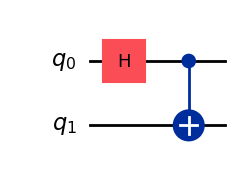Getting started¶
This tutorial shows you how to get started with the povm_toolbox.
[1]:
%load_ext autoreload
%autoreload 2
Compute circuit output probabilities with POVMSampler¶
Follow these instructions to get the probability distribution of a quantum circuit with the povm_toolbox.sampler.POVMSampler sampler.
Initialize QuantumCircuit¶
The first step is to create the qiskit.circuit.QuantumCircuits from which you want to obtain the probability distribution.
[2]:
from qiskit import QuantumCircuit
qc = QuantumCircuit(2)
qc.h(0)
qc.cx(0, 1)
qc.draw("mpl", style="iqp")
[2]:

Note:
The
qiskit.circuit.QuantumCircuityou pass topovm_toolbox.sampler.POVMSamplermust not include measurements. These will later be specified by the chosen POVM.
Initialize Sampler and POVMSampler¶
Next, create a povm_toolbox.sampler.POVMSampler instance, which will internally use a qiskit.primitives.Sampler instance.
[3]:
from numpy.random import default_rng
from povm_toolbox.sampler import POVMSampler
from qiskit.primitives import StatevectorSampler as Sampler
rng = default_rng(22)
sampler = Sampler(seed=rng)
povm_sampler = POVMSampler(sampler=sampler)
Initialize measurement procedure¶
Next, create a povm_toolbox.library.POVMImplementation instance.
[4]:
from povm_toolbox.library import ClassicalShadows
measurement = ClassicalShadows(num_qubits=2, seed=12)
Run and get results¶
Now that you have defined your povm_sampler, run it by calling the povm_toolbox.sampler.POVMSampler.run method, which returns an instance of povm_toolbox.sampler.POVMSamplerJob. You can get the results from the job (as a qiskit.primitives.PrimitiveResult object) with the povm_toolbox.sampler.POVMSamplerJob.result method.
[5]:
job = povm_sampler.run([qc], shots=256, povm=measurement)
result = job.result()
print(result)
PrimitiveResult([POVMPubResult(data=DataBin(povm_measurement_creg=BitArray(<shape=(), num_shots=256, num_bits=2>)), metadata=RPMMetadata(povm_implementation=ClassicalShadows(num_qubits=2), composed_circuit=<qiskit.circuit.quantumcircuit.QuantumCircuit object at 0x000001E6C4698F10>, pvm_keys=np.ndarray<256,2>))], metadata={'raw_results': PrimitiveResult([SamplerPubResult(data=DataBin(povm_measurement_creg=BitArray(<shape=(256,), num_shots=1, num_bits=2>), shape=(256,)), metadata={'shots': 1})], metadata={})})
While this example only uses one qiskit.circuit.QuantumCircuit, you can sample multiple circuits by passing a list of povm_toolbox.sampler.POVMSamplerPubLike objects to the povm_toolbox.sampler.POVMSampler.run method.
For each supplied POVMSamplerPub, the resulting PrimitiveResult object stores a corresponding povm_toolbox.sampler.POVMPubResult object.
Get the outcome counts¶
From these results you can extract the outcome counts with the method povm_toolbox.sampler.POVMPubResult.get_counts.
[6]:
pub_result = result[0]
counts = pub_result.get_counts()
print(counts, type(counts))
[Counter({(0, 0): 20, (4, 5): 18, (4, 0): 14, (5, 4): 13, (1, 1): 13, (4, 3): 12, (1, 5): 11, (2, 2): 10, (4, 2): 10, (0, 5): 9, (1, 4): 9, (3, 3): 8, (0, 2): 8, (1, 2): 7, (0, 4): 7, (2, 4): 7, (5, 0): 7, (4, 1): 7, (5, 2): 7, (2, 0): 7, (1, 3): 6, (0, 3): 6, (2, 1): 6, (5, 1): 6, (2, 5): 6, (5, 3): 5, (3, 5): 5, (3, 1): 5, (3, 0): 4, (3, 4): 3})] <class 'numpy.ndarray'>
Instead of counts, you can also query the individual samples of the POVM measurement outcomes with the method povm_toolbox.sampler.POVMPubResult.get_samples.
[7]:
samples = pub_result.get_samples()
print(samples[:5], type(samples)) # the first 5 samples
[(1, 2), (5, 4), (0, 4), (1, 1), (3, 0)] <class 'list'>
Compute an expectation value with the POVMPostProcessor¶
After having sampled some POVM outcomes, follow these instructions to get the expected value of an observable for a given quantum circuit with the povm_toolbox.post_processor.POVMPostProcessor.
Initialize observables¶
The first step is to define the observables whose expected value you want to compute. Each observable can be any BaseOperator, like the operators from qiskit.quantum_info. Among them it is preferable to use qiskit.quantum_info.SparsePauliOp.
[8]:
from qiskit.quantum_info import SparsePauliOp
observable = SparsePauliOp(["II", "XX", "YY", "ZZ"], coeffs=[1, 1, -1, 1])
Initialize the POVMPostProcessor¶
A POVMPostProcessor is initialized with an instance of a POVMPubResult.
[9]:
from povm_toolbox.post_processor import POVMPostProcessor
post_processor = POVMPostProcessor(pub_result)
Get the expected value¶
One can request the expectation value of an observable with the method povm_toolbox.post_processor.POVMPostProcessor.get_expectation_value.
[10]:
exp_value, std = post_processor.get_expectation_value(observable)
print(exp_value)
3.8828125
For reference, we can compare our estimated expectation value to the exact value.
The post-processor can also compute the (estimated) standard deviation of the estimator we built.
[11]:
import numpy as np
from qiskit.quantum_info import Statevector
exact_expectation_value = np.real_if_close(Statevector(qc).expectation_value(observable))
print(f"Exact value: {exact_expectation_value}")
exp_value, std = post_processor.get_expectation_value(observable)
print(f"Estimated value: {exp_value}")
print(f"\nEstimated standard deviation of the estimator: {std}")
Exact value: 3.999999999999999
Estimated value: 3.8828125
Estimated standard deviation of the estimator: 0.26297472173936615